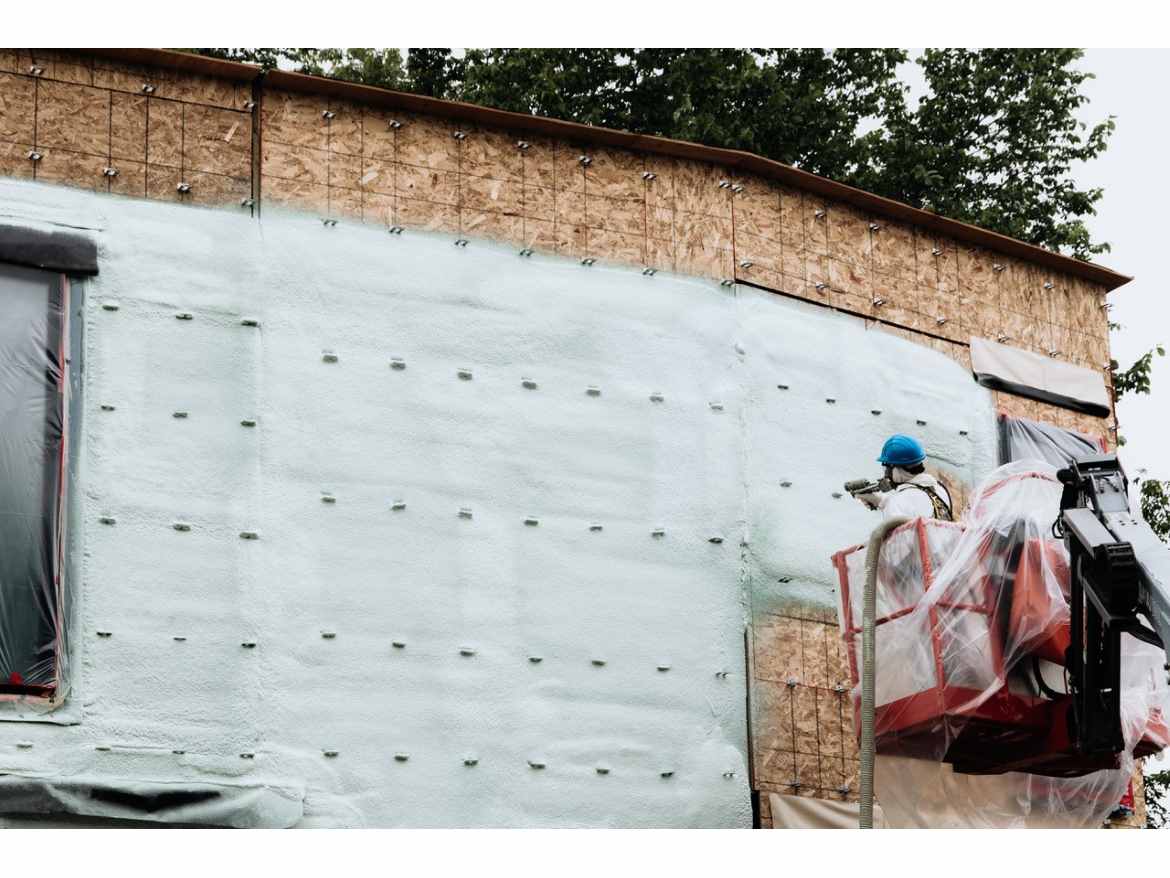Have you ever thought about using spray foam insulation outside? It's a versatile material that can be used both inside and outside. We'll look into whether spray foam can be used outside, what types are best for the outdoors, and the good and bad sides of using it outside.
Key Takeaways
- Spray foam insulation can be used for outdoor applications, but certain types are better suited than others.
- Closed-cell spray foam is more water-resistant and provides better insulation properties for exterior use.
- Proper preparation and application techniques are crucial when using spray foam outdoors to ensure long-lasting performance.
- Protecting outdoor spray foam from UV exposure is essential to prevent degradation and ensure its durability.
- Weighing the advantages and disadvantages of using spray foam outside is important to make an informed decision for your project.
Introduction to Spray Foam Insulation
Spray foam insulation is changing the game in home insulation. It's applied as a liquid and quickly expands to fill every space, creating a strong barrier against air and moisture. This makes it great for insulating walls, attics, or crawl spaces. Spray foam insulation boosts your home's energy efficiency and air quality.
What is Spray Foam Insulation?
Spray foam insulation is a mix of two materials sprayed onto surfaces. It expands to form a solid layer that seals and insulates well. Its closed-cell or open-cell structure gives it top-notch thermal and air-sealing properties. This makes it perfect for homes, businesses, and industrial projects.

Benefits of Spray Foam Insulation
Using spray foam insulation has many benefits. It's a top-notch insulator that cuts energy costs and boosts comfort. It also seals air leaks, which means cleaner air inside by keeping out allergens and pollutants. Plus, it's tough against moisture and can even make your building stronger.
- Superior insulation properties
- Effective air sealing to improve energy efficiency
- Enhanced indoor air quality by preventing allergen and pollutant infiltration
- Durable and moisture-resistant material
- Potential to strengthen building structure
Read More: Benefits of Spray Foam Insulation
Can Spray Foam Be Used Outside?
Spray foam insulation is often thought of for inside use, but spray foam can be used outside. Only some spray foam types are good for the outside, though. When using spray foam outdoors, we must think about how to protect it from the weather and keep it insulated.
Choosing the right spray foam type is key for using spray foam outdoors. Open-cell spray foam isn't great for the outside because it can get damaged by moisture and sunlight. Closed-cell spray foam, however, can handle the weather well and offers strong weatherproof spray foam protection.
How to use closed-cell foam outside
To properly use closed-cell foam in an exterior application, you must protect it from the elements.
- For roofing: Install an elastomeric top coating (e.g., silicone, acrylic, or urethane) over the foam to prevent UV degradation. This coating must be reapplied every 10–15 years.
- For exterior walls: Spray the foam into the wall cavities from the outside after removing the old sheathing. Once installed and trimmed, cover it with a protective coating, a vapor barrier, and then a new layer of sheathing and siding. Alternatively, you can frame the exterior walls, spray the foam into the new cavities, and then install sheathing and siding.
- For concrete: Use a specialized two-pound closed-cell foam for in-ground contact to insulate surfaces like foundations and exterior concrete slabs.
Types of Spray Foam Insulation
When looking at spray foam for outdoor projects, knowing the types is key. There are two main kinds: open-cell and closed-cell spray foam. Each has its own strengths for different uses.
Open-Cell Spray Foam
Open-cell spray foam is light and lets air through. It's not the top pick for outdoors because it can get damaged by moisture and UV rays. This foam is good for keeping warmth in, but it might not work well outside or in outdoor buildings.
Closed-Cell Spray Foam
Closed-cell spray foam is thicker and stronger, perfect for the outdoors. It keeps air and moisture out, making it great for outdoor projects. This foam is more durable and can handle the weather better, making it a solid choice for outdoor insulation.
Knowing the differences between open-cell and closed-cell spray foam is crucial for outdoor projects. Picking the right type depends on the project's needs and conditions. This ensures the foam works well and protects the area for a long time.
Advantages of Using Spray Foam Outdoors
Spray foam insulation is great for more than just indoor use. It's also perfect for spray foam weatherproofing and spray foam insulation for roofs, exterior walls, and other outdoor enclosures. Let's look at the main benefits of using spray foam for outdoor applications.
Weather Resistance
Using spray foam outdoors is a smart move because it's weather-resistant. Closed-cell spray foam is especially good at keeping out moisture, wind, and temperature changes. This makes it perfect for sealing and insulating outdoor areas. It keeps the elements out, ensuring your outdoor spaces last longer and perform better.
Insulation Properties
Spray foam insulation also boosts the insulation of outdoor spaces. It seals and insulates exterior walls and roofs well. This can cut down on heating and cooling costs. Spray foam is a smart choice for making outdoor living areas, sheds, garages, and other structures more comfortable and efficient.
Disadvantages of Using Spray Foam Outdoors
Using spray foam outside has its downsides. One big issue is how it reacts to UV rays. These rays can make the foam break down, leading to cracks or color changes.
Also, spray foam outside might get damaged by hail or falling objects. This damage can make the insulation less effective and might even cause structural problems if not fixed.
To avoid these problems, it's important to prepare well before applying the foam. Make sure the surface is ready, apply the foam in good weather, and protect it from UV rays. These steps help keep the foam working well for a long time outside.
When thinking about using spray foam outside, consider both the good and the bad. Knowing the risks and taking steps to prevent them helps ensure spray foam insulation works well and lasts long outside.
Preparation for Outdoor Spray Foam Application

Using spray foam outside, like for exterior or weather-resistant sealant, needs careful prep. Before starting your outdoor spray foam project, follow some important steps for a good result.
Surface Preparation
Getting the surface ready is key for the foam to stick well. This might mean cleaning, degreasing, or priming the area. Make sure it's clean, dry, and smooth. This helps the foam bond well, making a strong and weatherproof seal.
Weather Conditions
The weather at the time of foam application is crucial. The temperature and humidity must be right for the foam. Bad weather can cause the foam not to work well, leading to issues like poor curing or early wear.
- Check the manufacturer's guidelines for the best temperature and humidity for your foam.
- Don't apply foam when it's raining, windy, or too hot or cold.
- Watch the weather forecast and plan your project for the best results.
By preparing the surface well and checking the weather, you're ready for a successful outdoor spray foam job. This ensures your project gets the insulation, sealing, and weatherproofing it needs.
Outdoor Spray Foam Application Techniques
Applying spray foam insulation outside requires special techniques for good adhesion and performance. Using the right methods helps avoid issues like cracking or uneven coverage. These problems can lessen the foam's protective effect outdoors.
For outdoor spray foam, use equipment made for the outdoors. This includes spray guns with long nozzles and portable mixing stations. Paying attention to mixing and applying the foam correctly is key to getting good results.
It's better to spray the foam in thin layers rather than one thick layer. This helps with sticking and makes sure the surface is fully covered. Watching the foam's thickness and consistency as you spray keeps it working well.
- Use specialized equipment designed for spray foam for outdoor projects
- Apply the foam in multiple thin layers for better adhesion
- Carefully monitor thickness and consistency during application
By following these tips, contractors can make sure the spray foam lasts long and works well in tough outdoor conditions.
UV Protection for Outdoor Spray Foam

To protect outdoor spray foam from UV damage, it's key to use a protective coating or covering. Options include UV-resistant spray foam coatings and physical barriers like metal or acrylic panels. Keeping up with maintenance and reapplying these protections is vital for the foam's long-term use outdoors.
Protective Coatings
Top-notch UV-resistant spray foam coatings shield the foam from the sun's harmful UV rays. They not only protect but also boost the spray foam moisture protection and weatherproofing. This makes them a must-have for spray foam roofing and closed-cell spray foam exterior use.
Maintenance and Reapplication
Regular checks and upkeep are key to keeping the protective coatings effective. Over time, these coatings can break down or wear off, needing reapplication. By being proactive and addressing issues early, you can keep your outdoor spray foam in top shape. This ensures it continues to offer great insulation and weatherproofing.
FAQ
Can spray foam be used outside?
Yes, spray foam can be used outside. But you need to pick the right type and take safety steps. Not all spray foam works well outside because it must handle UV rays, moisture, and temperature changes.
What are the different types of spray foam for outdoor use?
There are two main types of spray foam outside: open-cell and closed-cell. Open-cell foam is more open and less dense, but it is not great for outside because it gets damaged by moisture and UV. Closed-cell foam is denser and stiffer, and it fights moisture and air better, making it good for outside use.
What are the advantages of using spray foam outdoors?
Spray foam outside is great for its weather resistance and insulation. Closed-cell foam stands up well to moisture, wind, and temperature changes. It's perfect for sealing and insulating outside areas, walls, and roofs. Spray foam also boosts energy efficiency and cuts down on heating and cooling costs outside.
What are the disadvantages of using spray foam outdoors?
Spray foam outside has some downsides. UV rays can break it down, causing it to crack, peel, or change color. It can also get damaged by things like hail or falling objects. Making sure it's applied right and protected is key to its success and lasting power.
How do I prepare for outdoor spray foam application?
Get your surface ready and check the weather before applying spray foam outside. Clean and prime the area for better stickiness. Make sure the temperature and humidity are right for the foam to work well and last long.
How do I apply spray foam for outdoor use?
When applying spray foam outside, special skills are needed for it to stick and protect well. Use the right tools, layer the foam, and watch the coverage and thickness. Doing it right helps avoid problems like cracking or unevenness that can hurt the foam's outdoor performance.
How do I protect outdoor spray foam from UV damage?
To shield spray foam from UV damage, use a protective coating or covering. Try UV-resistant coatings or metal or acrylic panels. You should reapply these protections often to keep the foam working well outside.




